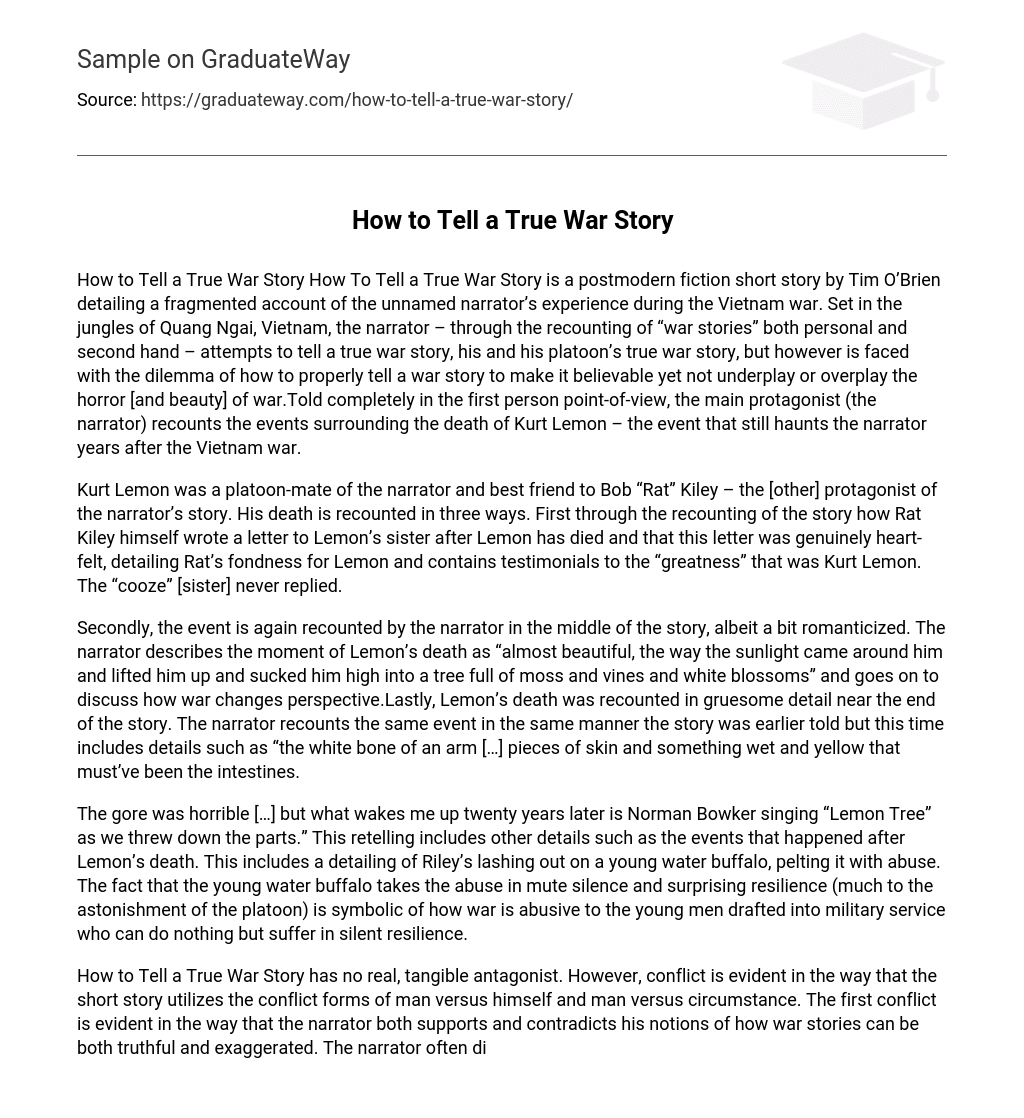How To Tell a True War Story is a postmodern fiction short story by Tim O’Brien detailing a fragmented account of the unnamed narrator’s experience during the Vietnam war. Set in the jungles of Quang Ngai, Vietnam, the narrator – through the recounting of “war stories” both personal and second hand – attempts to tell a true war story, his and his platoon’s true war story, but however is faced with the dilemma of how to properly tell a war story to make it believable yet not underplay or overplay the horror [and beauty] of war.Told completely in the first person point-of-view, the main protagonist (the narrator) recounts the events surrounding the death of Kurt Lemon – the event that still haunts the narrator years after the Vietnam war.
Kurt Lemon was a platoon-mate of the narrator and best friend to Bob “Rat” Kiley – the [other] protagonist of the narrator’s story. His death is recounted in three ways. First through the recounting of the story how Rat Kiley himself wrote a letter to Lemon’s sister after Lemon has died and that this letter was genuinely heart-felt, detailing Rat’s fondness for Lemon and contains testimonials to the “greatness” that was Kurt Lemon. The “cooze” [sister] never replied.
Secondly, the event is again recounted by the narrator in the middle of the story, albeit a bit romanticized. The narrator describes the moment of Lemon’s death as “almost beautiful, the way the sunlight came around him and lifted him up and sucked him high into a tree full of moss and vines and white blossoms” and goes on to discuss how war changes perspective.Lastly, Lemon’s death was recounted in gruesome detail near the end of the story. The narrator recounts the same event in the same manner the story was earlier told but this time includes details such as “the white bone of an arm pieces of skin and something wet and yellow that must’ve been the intestines.
The gore was horrible but what wakes me up twenty years later is Norman Bowker singing “Lemon Tree” as we threw down the parts.” This retelling includes other details such as the events that happened after Lemon’s death. This includes a detailing of Riley’s lashing out on a young water buffalo, pelting it with abuse. The fact that the young water buffalo takes the abuse in mute silence and surprising resilience (much to the astonishment of the platoon) is symbolic of how war is abusive to the young men drafted into military service who can do nothing but suffer in silent resilience.
How to Tell a True War Story has no real, tangible antagonist. However, conflict is evident in the way that the short story utilizes the conflict forms of man versus himself and man versus circumstance. The first conflict is evident in the way that the narrator both supports and contradicts his notions of how war stories can be both truthful and exaggerated. The narrator often discusses that in the recounting of war stories, facts are jumbled, angles are skewed, points are missed and that there will “always [be] that surreal seemingness.
”The second conflict is evident in the way that the narrator struggles with telling war stories since most listeners, especially those who have no firsthand experience of war, have a singular view of war (as atrocious). It is the narrator’s perspective of war that drives his notion at conflict with his listener/reader’s for to the narrator, war is a pradox. It is both horrifying and beautiful, where “ right spills over into wrong, order blends into chaos, love into hate, ugliness into beauty, law into anarchy, civility into savagery.” War to the narrator is absolute ambiguity.
To recount a true war story is to tell all of these swirling concepts equally, with no bias or embellishments. To tell a true war story is to tell a story that is really not about the war, but a story all about “love and memory, about sorrow, about sisters who never write back and people who never listen.”
Work Cited
- O’Brien, Tim. “How to Tell a True War Story,” in Paula Geyh, et al. , eds., Postmodern American Fiction: A Norton Anthology (New York: W. W. Norton, 1998), 174-183.





